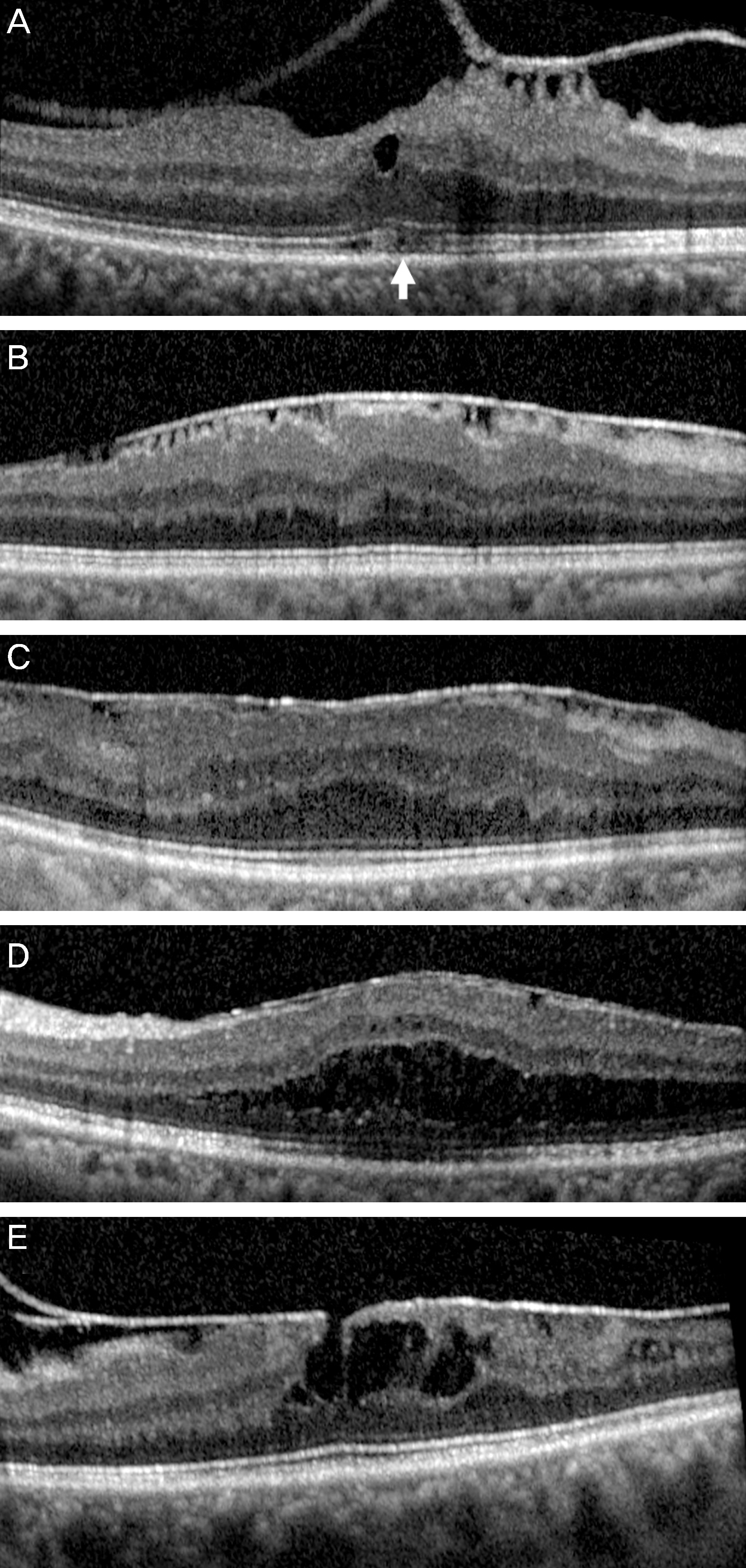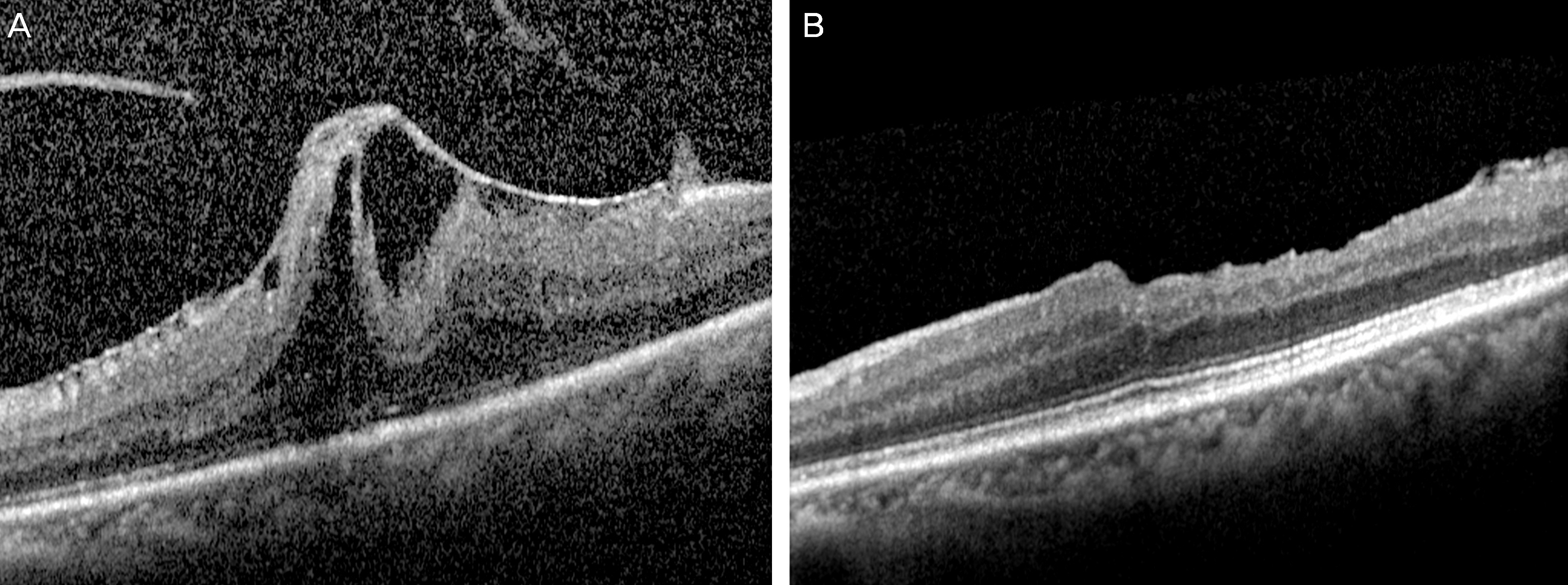J Korean Ophthalmol Soc.
2014 Dec;55(12):1834-1842. 10.3341/jkos.2014.55.12.1834.
Surgical Outcomes in Epiretinal Membrane According to the Presence of Vitreomacular Traction Syndrome
- Affiliations
-
- 1Department of Ophthalmology, Daegu Fatima Hospital, Daegu, Korea. Mjmom99@naver.com
- KMID: 2338971
- DOI: http://doi.org/10.3341/jkos.2014.55.12.1834
Abstract
- PURPOSE
To present preoperative macular structure deformities and surgical outcomes in idiopathic epiretinal membrane (ERM) patient according to the presence of vitreomacular traction syndrome (VMTS).
METHODS
This retrospective observational study included 54 eyes of 51 patients with idiopathic ERM, who underwent pars plana vitrectomy with ERM and internal limiting membrane (ILM) peeling, and were followed for more than 6 months. Subjects were classified into 2 groups according to the presence of VMTS using preoperative optical coherence tomography (group 1: ERM without VMTS, 29 eyes; group 2: ERM with VMTS, 22 eyes). Preoperative macular structure deformity and surgical outcomes were compared and prognostic factors were analyzed.
RESULTS
Group 1 (ERM without VMTS) included 29 eyes, and group 2 (ERM with VMTS) included 22 eyes. Group 2 had a significantly higher occurrence of lamellar macular hole and a significantly lower preoperative best-corrected visual acuity (BCVA) compared to group 1. However, final postoperative BCVAs were not significantly different between the groups because BCVA changed more in group 2. Preoperative macular structure deformities (irregular retinal surface, retinal thickening, lamellar macular hole, and cystoid macular edema) did not affect visual outcomes. The presence of photoreceptor inner segment/outer segment (IS/OS) junction disruption and preoperative BCVA were highly related with visual outcomes.
CONCLUSIONS
BCVA significantly improved in idiopathic ERM patients who underwent pars plana vitrectomy with ERM and ILM peeling regardless of the presence of VMTS. There may be a stronger association of IS/OS junction disruption with visual acuity compared to VMTS in idiopathic ERM surgery.
Keyword
MeSH Terms
Figure
Reference
-
References
1. Wickham L, Gregor Z. Epiretinal membrane. Ryan SJ, editor. Retina. 5th ed.Baltimore: Elsevier;2013. 3:chap. 116.2. Kampik A. Pathology of epiretinal membrane, idiopathic macular hole, and vitreomacular traction syndrome. Retina. 2012; 32:S194–8. discussion S198-9.
Article3. Zhao F, Gand, orfer A, Haritoglou C, et al. Epiretinal cell proliferation in macular pucker and vitreomacular traction syndrome: analysis of flat-mounted internal limiting membrane specimens. Retina. 2013; 33:77–88.4. Seo SJ, Lee SJ, Park JM. Surgical outcome according to morphology in epiretinal membrane based on optical coherence tomography (OCT). J Korean Ophthalmol Soc. 2013; 54:736–44.
Article5. Lee P, Lee TG, Kim MS, et al. Prognostic factors in vitrectomy for macular epiretinal membrane. J Korean Ophthalmol Soc. 2011; 52:1302–7.
Article6. Vinores SA, Campochiaro PA, Conway BP. Ultrastructural and electron-immunocytochemical characterization of cells in epiretinal membranes. Invest Ophthalmol Vis Sci. 1990; 31:14–28.7. Gupta P, Yee KM, Garcia P, et al. Vitreoschisis in macular diseases. Br J Ophthalmol. 2011; 95:376–80.
Article8. Spaide RF. Vitreomacular traction syndrome. Retina. 2012; 32(Suppl 2):S187–90. discussion S190-3.
Article9. Koizumi H, Spaide RF, Fisher YL, et al. Three-dimensional evaluation of vitreomacular traction and epiretinal membrane using spectral-domain optical coherence tomography. Am J Ophthalmol. 2008; 145:509–17.
Article10. Sonmez K, Capone A Jr, Trese MT, Williams GA. Vitreomacular traction syndrome: impact of anatomical configuration on anatomical and visual outcomes. Retina. 2008; 28:1207–14.11. Yamada N, Kishi S. Tomographic features and surgical outcomes of vitreomacular traction syndrome. Am J Ophthalmol. 2005; 139:112–7.
Article12. Odrobina D, Michalewska Z, Michalewski J, et al. Long-term evaluation of vitreomacular traction disorder in spectral-domain optical coherence tomography. Retina. 2011; 31:324–31.
Article13. Bottós JM, Elizalde J, Rodrigues EB, Maia M. Current concepts in vitreomacular traction syndrome. Curr Opin Ophthalmol. 2012; 23:195–201.
Article14. Kinoshita T, Kovacs KD, Wagley S, Arroyo JG. Morphologic differences in epiretinal membranes on ocular coherence tomography as a predictive factor for surgical outcome. Retina. 2011; 31:1692–8.
Article15. Wong JG, Sachdev N, Beaumont PE, Chang AA. Visual outcomes following vitrectomy and peeling of epiretinal membrane. Clin Experiment Ophthalmol. 2005; 33:373–8.
Article16. Lee HJ, Kim HC. The clinical outcome and prognostic factors of vitrectomy for macular epiretinal membranes. J Korean Ophthalmol Soc. 2003; 44:857–64.17. Kim CH, Kim JI, Cho HY, Kang SW. Correlation between preoperative OCT pattern and visual improvement in macular epiretinal membrane. J Korean Ophthalmol Soc. 2007; 48:75–82.18. Suh MH, Seo JM, Park KH, Yu HG. Associations between macular findings by optical coherence tomography and visual outcomes after epiretinal membrane removal. Am J Ophthalmol. 2009; 147:473–80.e3.
Article19. Ahn SJ, Ahn J, Woo SJ, Park KH. Photoreceptor change and visual outcome after idiopathic epiretinal membrane removal with or without additional internal limiting membrane peeling. Retina. 2014; 34:172–81.
Article20. Park DW, Dugel PU, Garda J, et al. Macular pucker removal with and without internal limiting membrane peeling: pilot study. Ophthalmology. 2003; 110:62–4.
Article21. Sandali O, El Sanharawi M, Basli E, et al. Epiretinal membrane recurrence: incidence, characteristics, evolution, and preventive and risk factors. Retina. 2013; 33:2032–8.
- Full Text Links
- Actions
-
Cited
- CITED
-
- Close
- Share
- Similar articles
-
- Clinical Manifestation and Result of Vitrectomy of Vitreomacular Traction Syndrome
- Spontaneous Resolution of Cataract-related Acute Vitreomacular Traction Syndrome
- Diagnosis and Treatment of Vitreomacular Traction Syndrome Using Optical Coherence Tomography
- Surgical Outcome According to Morphology in Epiretinal Membrane Based on Optical Coherence Tomography (OCT)
- Choroidal Thickness Changes Following Vitrectomy in Epiretinal Membrane Based on the Optical Coherence Tomography Pattern





